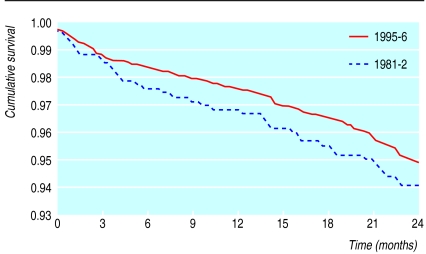Improvements in coronary revascularisation techniques and an increase in the use of percutaneous interventions1 have led to a rise in the number of coronary artery bypass grafting operations in older patients with more severe cardiac disease and worse comorbidity and who have previously undergone revascularisation procedures.2,3 Advances in surgical and anaesthetic techniques have prevented a worsening risk profile from being translated into an increase in perioperative deaths.2,3 The aim of our study was to examine time trends in major outcomes up to two years after coronary artery bypass grafting.
Participants, methods, and results
We used the Scottish morbidity record (SMR1) system to identify all operations for coronary artery bypass grafting performed in Scottish NHS hospitals from 1981 to 1996. We excluded operations that included other procedures. Information was obtained on age, sex, urgency of the operation, and Carstairs socioeconomic deprivation category derived from postcode of residence.4 Record linkage to subsequent SMR1 and registrar general records provided follow up information on readmission, repeat procedures, and death, both inside and outside of hospital, up to two years after the operation.
The study cohort comprised 25 229 coronary artery bypass operations; 19 687 (78%) were performed in men and 5542 (22%) in women. The number of operations overall increased from 68 to 490 per million population per year (see table A on the BMJ 's website for details). The percentage of operations performed on patients aged over 65 increased from 2% to 30% in men (7/289 v 582/1950, P<0.0001) and from 16% to 45% in women (10/61 v 266/586, P<0.0001). No significant time trends in deprivation category or urgency were found. After adjustment for age in a Cox proportional hazards model, the risk of all cause mortality up to two years after the operation significantly declined in men over the study period (figure; see equivalent graph for women on website). Readmission for a principal cause of ischaemic heart disease also declined in men over the period (P<0.0001), whereas repeat coronary angiography increased (P<0.0001; see table B on website). There was no obvious trend in repeat coronary revascularisation procedures. Similar time trends were seen in women, but only the time trend in repeat coronary angiography reached significance (P<0.0001).
Comment
During 1981-96 the risk of death within two years of coronary artery bypass grafting and the need for readmission decreased significantly in men after data had been adjusted for age. The age of patients undergoing coronary artery bypass grafting has significantly increased; this agrees with previous studies.2,3,5 These improvements are likely to reflect developments in surgical technique, such as increased use of internal mammary artery grafts and of secondary prevention.2,3,5 The failure of the results to reach statistical significance in women may simply reflect the fact that fewer procedures are carried out in women. The number of repeat coronary angiography procedures increased significantly in both sexes. However, the number of readmissions for ischaemic heart disease declined and there were no obvious increases in repeat coronary revascularisation; thus the increase in repeat angiography is more likely to reflect a reduced threshold for investigation than deteriorating outcomes.
Because the study was based on routine data, we were unable to adjust for possible changes in comorbidity or severity of cardiac disease. However, studies from Europe, the Far East, and the United States have consistently shown worsening risk profiles in relation to both of these.2,3,5 Therefore, failure to adjust for these is likely to have led to an underestimate of the improvements made.
Supplementary Material
Figure.
Age adjusted cumulative survival in men up to two years after coronary artery bypass grafting in 1981-2 and 1995-6
Footnotes
Funding: British Heart Foundation.
Competing interests: None declared.
See the BMJ's website for more data on coronary artery grafts 1981-96
References
- 1.Delacretaz E, Meier B. Use of coronary angioplasty, bypass surgery, and conservative therapy for treatment of coronary artery disease over the past decade. Eur Heart J. 1998;19:1042–1046. doi: 10.1053/euhj.1997.0801. [DOI] [PubMed] [Google Scholar]
- 2.Haraphongse M, Na-Ayudhya RK, Teo KK, Williams R, Bay KS, Gelfand E, et al. The changing clinical profile of coronary artery bypass graft patients, 1970-89. Can J Cardiol. 1994;10:71–76. [PubMed] [Google Scholar]
- 3.Nishioka H, Taniguchi S, Kawata T, Mizuguchi K, Kameda Y, Sakaguchi H, et al. Impact of percutaneous transluminal coronary angioplasty on coronary bypass surgery—changes in the patient profile during the past decade. Jpn Circ J. 1998;62:665–669. doi: 10.1253/jcj.62.665. [DOI] [PubMed] [Google Scholar]
- 4.Carstairs V, Morris R. Deprivation and health in Scotland. Aberdeen: Aberdeen University Press; 1991. [Google Scholar]
- 5.Black N, Langham S, Petticrew M. Trends in the age and sex of patients undergoing coronary revascularisation in the United Kingdom 1987-93. Br Heart J. 1994;72:317–320. doi: 10.1136/hrt.72.4.317. [DOI] [PMC free article] [PubMed] [Google Scholar]
Associated Data
This section collects any data citations, data availability statements, or supplementary materials included in this article.



